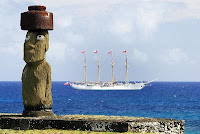Moai are monolithic human figures carved from rock on the Polynesian island of Easter Island, Chile between the years 1250 and 1500. Nearly half are still at Rano Raraku, the main moai quarry, but hundreds were transported from there and set on stone platforms called ahu around the island's perimeter. Almost all moai have overly large heads three-fifths the size of their bodies. The moai are chiefly the living faces of deified ancestors. The statues still gazed inland across their clan lands when Europeans first visited the island, but most would be cast down during later conflicts between clans.

The statues production and transportation is considered a remarkable intellectual, creative, and physical feat. The tallest moai erected, called Paro, was almost 10 metres or 33 ft high and weighed 75 tonnes which is the heaviest erected was a shorter but squatter moai at Ahu Tongariki, weighing 86 tons and one unfinished sculpture, if completed, would have been approximately 21 metres or 69 ft tall with a weight of about 270 tons.
The moai are monolithic statues, their minimalist style related to forms found throughout Polynesia. Moai are carved in relatively flat planes, the faces bearing proud but enigmatic expressions. The moai are whole-body statues, they are commonly referred to as "Easter Island heads". This is partly because of the disproportionate size of most moai heads and partly because, from the invention of photography until the 1950s, the only moai standing on the island were the statues on the slopes of Rano Raraku, many of which are buried to their shoulders. Some of the "heads" at Rano Raraku have been excavated and their bodies seen, and observed to have markings that had been protected from erosion by their burial.
All but 53 of the 887 moai known to date were carved from tuff or a compressed volcanic ash. At the end of carving, they would rub the statue with pumice from Rano Raraku, where 394 moai and incomplete moai are still visible today. Easter Island statues are known for their large, broad noses and strong chins, along with rectangle-shaped ears and deep eye slits.
In 1979, Sergio Rapu Haoa and a team of archaeologists discovered that the hemispherical eye sockets were designed to hold coral eyes with either black obsidian or red scoria pupils. The discovery was made by collecting and reassembling broken fragments of white coral that were found at the various sites. Subsequently, previously uncategorized finds in the Easter Island museum were re-examined and recategorized as eye fragments. It is thought that the moai with carved eye sockets were probably allocated to the ahu and ceremonial sites, suggesting that a selective Rapa Nui hierarchy was attributed to the moai design until its demise with the advent of the Birdman religion, Tangata Manu.
Some moai had pukao on their heads these were carved out of red scoria, a very light rock from a quarry at Puna Pau. When first carved, the surface of the moai was polished smooth by rubbing with pumice. Unfortunately, the easily worked tuff from which most moai were carved is also easily eroded, and, today, the best place to see the surface detail is on the few moai carved from basalt or in photographs and other archaeological records of moai surfaces protected by burial. Some of the moai were painted Hoa Hakananaia was decorated with maroon and white paint until 1868, when it was removed from the island. It is now housed in the British Museum, London.

 The statues were carved by the Polynesian colonizers of the island, mostly between circa 1250 CE and 1500 CE. In addition to representing deceased ancestors, the moai, once they were erected on ahu, may also have been regarded as the embodiment of powerful living or former chiefs and important lineage status symbols. Completed statues were moved to ahu mostly on the coast, then erected, sometimes with red stone cylinders or pukao on their heads. Moai must have been extremely expensive to craft and transport not only would the actual carving of each statue require effort and resources, but the finished product was then hauled to its final location and erected.
The statues were carved by the Polynesian colonizers of the island, mostly between circa 1250 CE and 1500 CE. In addition to representing deceased ancestors, the moai, once they were erected on ahu, may also have been regarded as the embodiment of powerful living or former chiefs and important lineage status symbols. Completed statues were moved to ahu mostly on the coast, then erected, sometimes with red stone cylinders or pukao on their heads. Moai must have been extremely expensive to craft and transport not only would the actual carving of each statue require effort and resources, but the finished product was then hauled to its final location and erected.The American archaeologist, William Mulloy, undertook extensive investigation of the production, transportation and erection of Easter Island's monumental statuary from 1955 to 1978. The Rapa Nui National Park and the moai are included on the 1994 list of UNESCO World Heritage sites and consequently the 1972 UN convention concerning the protection of the worlds cultural and natural heritage. The Easter Island Statue Project is the latest research and documentation project of the moai on Rapa Nui and the artifacts held in museums overseas. The purpose of the project is to understand the figures original use, context, and meaning, with the results being provided to the Rapa Nui families and the islands public agencies that are responsible for conservation and preservation of the moai.







No comments:
Post a Comment